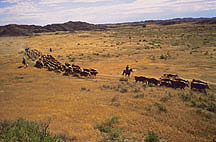This page has been archived and is being provided for reference purposes only. The page is no longer being updated, and therefore, links on the page may be invalid.
|
|
USDA Livestock and Range Research Lab Expansion UnveiledBy Erin PeabodyAugust 11, 2004 WASHINGTON, Aug. 11, 2004--The Agricultural Research Service dedicated new office and laboratory space Tuesday at its Fort Keogh Livestock and Range Research Laboratory in Miles City, Mont. The additions to the existing laboratory complex include three research units, 15 offices, a greenhouse and a meeting room where scientists can share their research findings with ranchers and the public. ARS is the chief scientific research agency of the U.S. Department of Agriculture. Situated in southeastern Montana, the Fort Keogh research facility covers 55,000 acres of mostly native rangeland. ARS runs the facility in cooperation with Montana State University's Agricultural Experiment Station. Ten ARS scientists there study animal genetics, nutrition and physiology, as well as rangeland science and ecology. Scientists at the laboratory use genetic evaluations to help develop beef cattle better suited for sustainable production. The laboratory maintains 1,500 beef cows, including 250 "Line 1" Herefords that are considered the oldest and purest line of Herefords in the world. For this reason, the research team leading the recently launched international bovine genome sequencing effort selected the Fort Keogh "Line 1" animals as the source of DNA for this landmark project. "Fort Keogh researchers were the first to study rangeland stocking rates in the entire Northern Great Plains," said ARS Administrator Edward B. Knipling. "Today, these researchers are recognized internationally for their work to develop sustainable range livestock production systems that meet the needs of producers and consumers." The researchers also develop grazing management strategies that take into consideration variables such as climate, especially drought; natural disturbances, like fire; invasive plants and the impact of various grazing tactics. A military outpost in the late 1880s, Fort Keogh was transferred to USDA in 1924 for use in agricultural research. |

